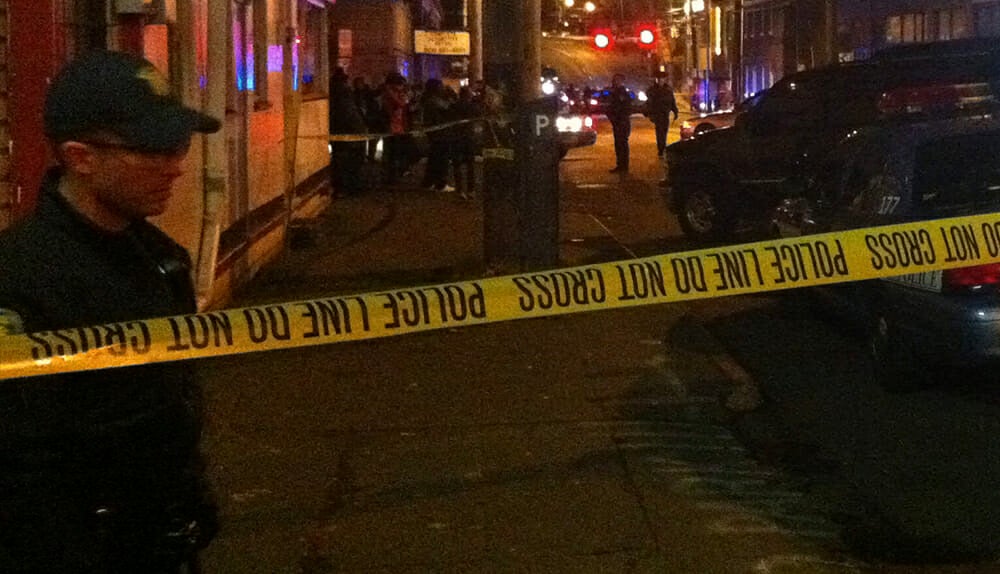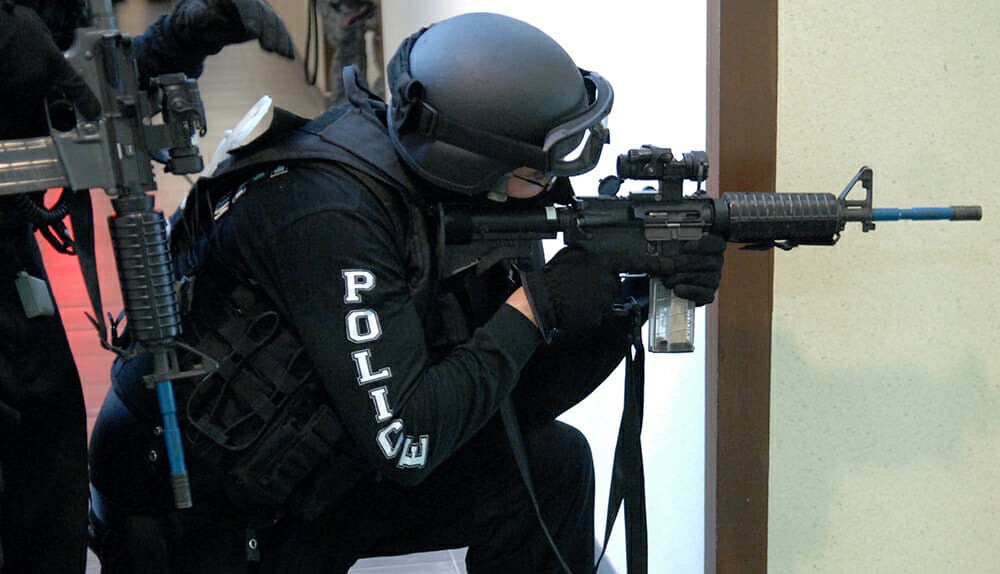Parkland survivor and gun control activist David Hogg has been the target of harassment by ring-wing conservatives ever since the deadly massacre of his classmates at Stoneman Douglas High School thrust him onto the national stage. The harassment turned dangerous earlier this month when Broward County police responded to a call at the Hogg residence. They were been told that an intruder armed with an AR-15 had taken the family hostage. Local authorities responded quickly and with force. When the police kicked down the door of the house, they found that there had never actually been an intruder at all. The Hoggs had been swatted.
What is swatting?

Swatting is the practice of summoning police to a home or place of business under false pretenses, and it has become a real problem in recent years. While some perpetrators have characterized swatting as harmless fun or a prank, the results can be deadly.
In December 2017, Kansas man Andrew Finch was shot and killed by police who were responding to a fake 911 call. The assailant was motivated by an online gaming dispute and mistakenly believed the person he was feuding with lived at Finch’s address. What began as an act of foolish internet bravado ended in senseless death.
Finch’s is the most tragic case of swatting, but by no means the only one to have serious consequences. A 20-year-old Maryland man was shot in the face with rubber bullets following a 2015 swatting call.
One swatter, a 16-year-old boy known online as “Obnoxious,” used the crime as one aspect of a campaign of serial harassment against dozens of women. Numerous female Twitch streamers across the United States have found heavily armed police at their doors, looking for assailants that didn’t exist.
The ever-advancing sophistication of the internet has enabled swatters, who are often tech-savvy enough to use fake caller IDs and employ other tactics to trick police law enforcement into coming to the wrong door. This process of faking a number, called “spoofing,” is often made possible by placing calls via Skype or on a burner phone.
READ MORE:
- How to destroy an American family
- The best 4 antivirus tools to keep your computer adware free
- How to protect yourself against email spoofing
The rise of swatting
It isn’t a coincidence that the Andrew Finch swatting case began around gaming. Gamers are a particularly tech-savvy community, and online gaming is a competitive environment where emotions run high. As such, prominent gamers in the community most commonly targeted in swatting cases.
Twitch was forced to change its terms of service to include a zero-tolerance policy on swatting, and the company has taken heat for the spike in incidents in recent years. Some experts recommend that avid gamers alert their local law enforcement that they could be targets of swatting. Female gamers are disproportionately targeted in these attacks.
Why does swatting work?
Swatting is possible in America because of the number of local law enforcement organizations with paramilitary capabilities. Heavily armed rapid response units, known as SWAT teams—which stands for Special Weapons And Tactics—came to prominence in the 1980s. Lax gun laws and the dueling “War on Drugs” and “War on Terror” have provided the rationale needed for small police departments to maintain heavy firepower.
A criminologist told the New York Times that 80 percent of municipalities with a population of between 25,000 and 50,000 have SWAT-level capabilities. While the spike in swatting has led to a conversation about harsher penalties for the crime, it has also contributed to the discussion around the militarization of police that has arisen in recent years.
A SWAT team, however, does not need to be sent in order for it to be considered swatting. The term applies anytime someone knowingly sends the police to a residence or business under false pretenses, such as a hostage situation or a suicide attempt. Swatting is effective because police have an obligation to immediately investigate such claims, even if they might suspect foul play.
Gamers are not the only victims of swatting, however. A rash of cases plagued Hollywood between 2012 and 2013. Justin Bieber, Ashton Kutcher, Miley Cyrus, Justin Timberlake, and Rihanna were all swatting victims. Because media attention was one of the motivating factors in the incidents, the Los Angeles Times and LAPD agreed to stop publicizing swatting attempts.
Though the dangers of the crime are becoming better understood, swatting videos still rack up millions of videos on YouTube, and swatters often take to social media to brag about their crimes. The FBI estimates over 400 incidents of swatting occur every year.
READ MORE:
- The best free password managers
- What’s the most secure operating system?
- How to encrypt an iPhone in seconds
How is swatting punished?

Swatting carries a felony charge in many states, and a number of perpetrators are doing prison time for placing these dangerous prank calls. Though punishments vary from state to state, the crime can carry around five years in prison and tens of thousands of dollars in ordered restitution. As swatting cases gain more national attention, there has been a push to increase these penalties.
Laws regarding internet behavior continue to lag behind more analog crimes. Prosecuting swatting cases has been difficult. However, some success stories have emerged when it comes to prosecuting swatting. The aforementioned Obnoxious was charged with 46 counts and pled guilty to 23. Had Obnoxious not turned out to be a minor (he was a 16-year-old Canadian boy with a history of abuse in his family), he would have likely done far more than the roughly year of jail time he received. In the tragic case of Andrew Finch, three men—Casey Viner, Shane Gaskill, and Tyler Barriss—are currently facing an array of federal criminal charges.
Congresswoman Katherine Clark (D-Mass.) has authored anti-swatting legislation, titled the “Interstate Swatting Hoax Act.” This law did not make it to the House floor, but provisions of the bill live on in her “Online Safety and Modernization Act,” which is still being considered and refined.
Heavy legal consequences and looming legislation haven’t stopped the trend from gaining steam. Sadly, many notable figures, from Rep. Clark to the meme makers behind “Damn Daniel” have found themselves victims of swatting.
As advances in technology make swatting easier, law enforcement officials and politicians are making serious strides in ensuring very serious punishments for this very serious crime. Only time will tell if these advances can prevent that next lethal phone call.


